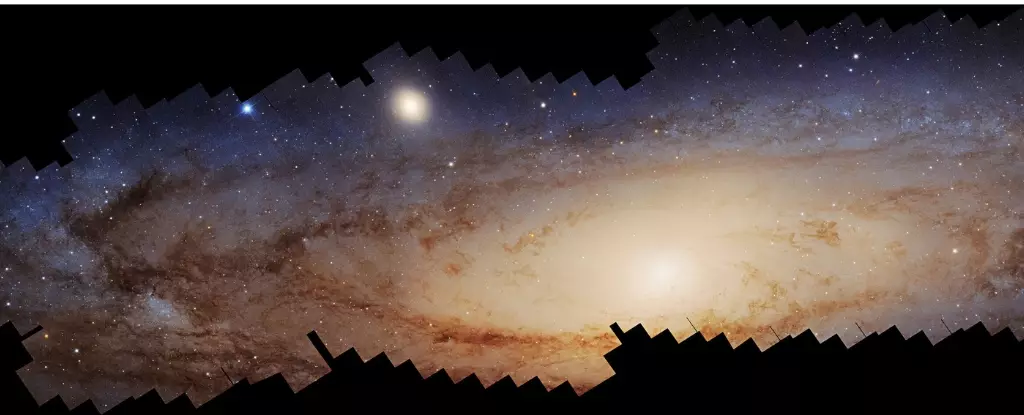The Andromeda Galaxy, known as M31, holds the title of the nearest spiral galaxy to our own Milky Way. This striking cosmic neighbor lies a mere 2.537 million light-years away, making it the most distant object visible to the naked eye under optimal conditions. As the largest galaxy in the Local Group—which includes the Milky Way and several dwarf galaxies—Andromeda has fascinated astronomers and stargazers alike. Its faint grey appearance may seem underwhelming from Earth, but this colossal galaxy is a treasure trove of astronomical wonders, with ongoing studies promising to illuminate not only its structure but also the complexities that define our own galaxy.
The Hubble Space Telescope, a cornerstone of modern astronomy, has extensively observed Andromeda, culminating in a jaw-dropping 2.5-gigapixel panorama that captures over 200 million stars. This ambitious project took a decade to complete, demonstrating the dedication and need for sophisticated technology in uncovering the mysteries of galactic structures. Hubble’s ability to detail the stellar population of Andromeda allows researchers to draw parallels to our galaxy, offering insights into the dynamics of a barred spiral galaxy without the challenges that typically accompany observations of more distant galaxies.
However, Hubble’s observations are merely a stepping stone in our understanding of galactic science. The European Space Agency’s Gaia mission aims to map the Milky Way in unprecedented detail, providing a different perspective on our position in the universe. Even though Gaia excels at detecting distances within our neighborhood, its limitations make Andromeda an essential subject for comparative studies.
As astronomers delve deeper into Andromeda, they recognize it as a crucial analog for studying the Milky Way. Its proximity circumvents many complications encountered in the observation of more distant galaxies, such as line-of-sight reddening, uncertain distances, and confusing background stars. M31 serves as a living laboratory, giving researchers the opportunity to explore the environmental context surrounding star formation rates, interstellar medium structures, and the metallicity of stars—a critical factor in understanding galactic evolution.
Recent advancements in observational programs, particularly the Panchromatic Hubble Andromeda Treasury (PHAT) and its follow-up, the Panchromatic Hubble Andromeda Southern Treasury (PHAST), have significantly enhanced the body of knowledge surrounding Andromeda. An important study published in the Astrophysical Journal not only reveals details about the stellar population but also spotlights contrasting features within the galaxy itself.
One of the standout findings from recent observational campaigns is the stark dissimilarity between Andromeda’s northern and southern disks. While the northern disk has been extensively studied, paving the way for a comprehensive understanding of its stellar composition, the southern disk has revealed a more tumultuous history marked by disturbances that hint at mergers with other galaxies. This variance raises fascinating questions about the galaxy’s formation and development.
Notably, the early-type dwarf galaxy M32 orbits Andromeda, suggesting a significant evolutionary event in the distant past, potentially a merger with a larger galaxy. The remnants of this collision may provide critical clues about Andromeda’s past, as they present properties that challenge conventional galaxy formation models. The tumultuous history of Andromeda is further highlighted by structures such as the Giant Southern Stream—a tidal debris stream composed of stars that serve as evidence of primordial interactions in this galactic neighborhood.
The ongoing observations of Andromeda paint a picture of a galaxy in transition—an intriguing hybrid of a star-forming spiral and an aging elliptical structure. Study co-author Daniel Weisz likens Andromeda to a “train wreck,” attributing its current state to past galactic collisions that triggered episodes of intense star formation before ultimately leading to a more subdued stellar activity. Such rich narratives about Andromeda’s past inform our broader understanding of galaxy evolution.
As we stand on the brink of more advanced observations, the anticipated launch of the Nancy Grace Roman Space Telescope promises to offer even more detailed insights into Andromeda and its nearby structures. Equipped with a wide field of view and advanced infrared capabilities, it has the potential to transform our understanding of not just Andromeda but also barred spiral galaxies as a whole.
The Andromeda Galaxy remains a beacon of study for astronomers seeking to comprehend the vast landscape of the universe. Its relatively close proximity and distinct characteristics make it an ideal candidate for unraveling the complexities of galactic evolution and formation. Ongoing studies fueled by powerful observational tools, such as the Hubble Space Telescope and upcoming missions like the Nancy Grace Roman Space Telescope, will undoubtedly provide deeper insights into both Andromeda and the Milky Way, bridging the gap between our cosmic neighborhood and the greater universe beyond.


Leave a Reply